When we think of marketing audits, we often think of content, PPC, and backlink audits. However, the internal link audit is one marketing audit we should pay more attention to as SEOs. When done correctly, this is a vital audit that can often lead to some of the quickest results you will see when running any SEO campaign.
This article will discuss internal link audits, why they’re essential for SEO, and the different types of internal links. We will also walk you through the step-by-step process of completing an internal link audit and show you vital screenshots.
What is an Internal Link Audit?
An internal link audit involves auditing a website’s internal linking structure to ensure that internal links are well organized and help with user navigation and search engine crawling.
When you complete an internal link audit on your website, you can identify issues such as broken links, redirect chains, or orphan pages that could be valuable for SEO. Additionally, it helps you assess whether a particular website’s internal linking strategy works well in distributing page authority and improving site structure.
It’s a crucial audit that enhances a website’s usability, can help you improve your rankings, and ensures users have a great experience navigating through it.
What are Internal Links?
An internal link points to a different page within your website. Unlike external links, which take users to a completely different domain, internal links connect various pages and resources within the same website.
If you want more information on internal links and how to utilize them for your SEO strategy, check out our internal linking guide.
Why are Internal Links Important for SEO?
I can’t stress enough how crucial internal links are for your website’s SEO.
A good internal link structure improves users’ experience on your website. Thanks to well-placed internal links, visitors delve deeper and deeper into your content, and they will (in general) stick around longer and bounce less. These user signals will help boost your site’s standing with search engines.
This is especially true now that we know Google uses click data (as we have speculated for years) as part of their ranking algorithm.
Along with user experience benefits, an excellent internal link structure helps search engines find and index your pages, significantly boosting your site’s visibility in the SERPs. Using internal links, you can quickly spread link equity across your website.
What are the Different Types of Internal Links?
Before you start your internal link audit, you need to be aware of many different types of internal links. Each has its own unique use in helping users navigate through your website and helping search engines discover your content, index it, and rank it.
The different types of internal links include:
How to Complete an Internal Link Audit
Let’s look at the steps you’ll need to undertake to complete an internal link audit on your website, including screenshots where needed.
Crawl Your Website
The first step to any internal link audit is to crawl your website entirely using a tool such as Screaming Frog or Sitebulb. While you can do this manually, if you have a very (and I do mean very) small website, you will almost always need to invest in a crawling tool, as it will save you a lot of time.
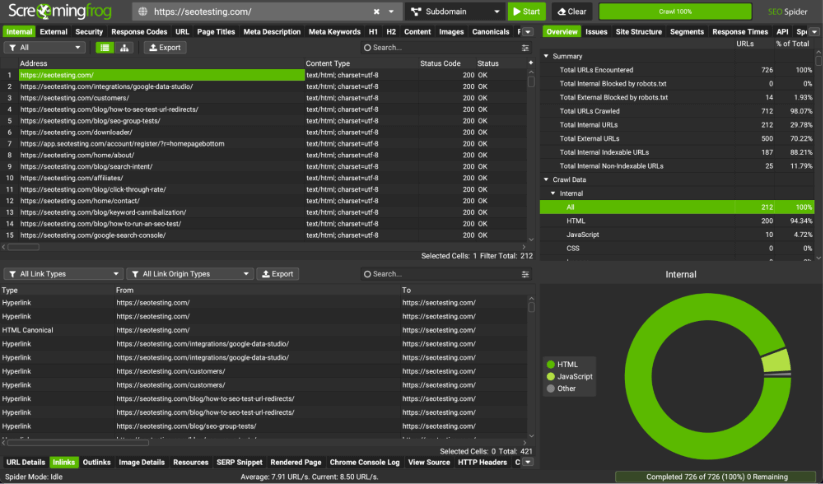
Before you start your website crawl, you must ensure that your crawler of choice is correctly configured to crawl the links. Within Screaming Frog, this is found in the crawl settings section of your application:

Once the crawl is complete, you will have a full list of all the accessible URLs on your website, which you can then move through, one by one, to find all the ‘inlinks’ and ‘outlinks’ on your website.
For context, on Screaming Frog, an inlink refers to links on your website that point to the page you are currently on, and an outlink refers to links from the page you are currently on to another page on your site.
Look for Problems
The next step is to look for problems with your internal links. During an internal link audit, the three main issues you tend to find are broken links, redirect chains, and links to pages that have since been redirected.
Broken Links
The first problem you usually encounter during an internal link audit of any website is broken internal links. Of course, you will find damaged external links, too, but we will focus on internal links only for an internal link audit.
Luckily, Screaming Frog makes finding broken internal links on your site quick and easy.
Simply click on the ‘Response Codes’ tab within your Screaming Frog audit, select the ‘Internal,’ and then filter it only to show links that respond with an ‘Internal Client Error (4xx)’ code. This will then show you all the broken internal links on your website.
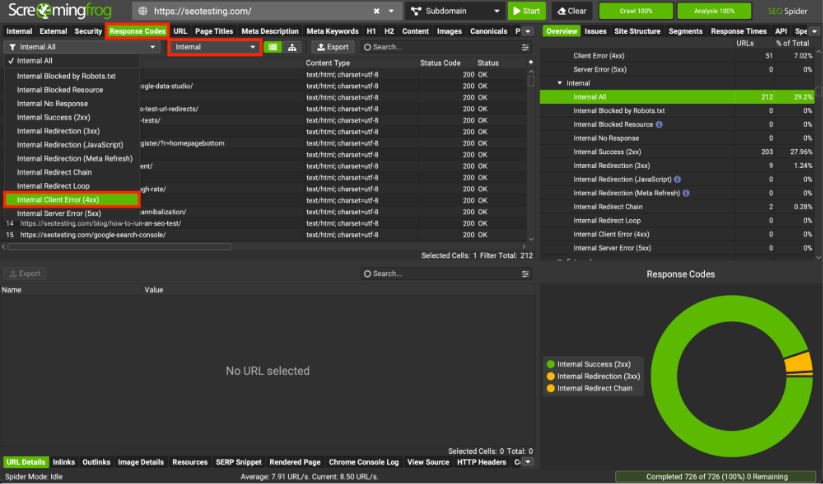
You can then find where these broken links are precisely on your website using the ‘Inlinks’ and ‘Outlinks’ tabs at the bottom of your Screaming Frog audit:
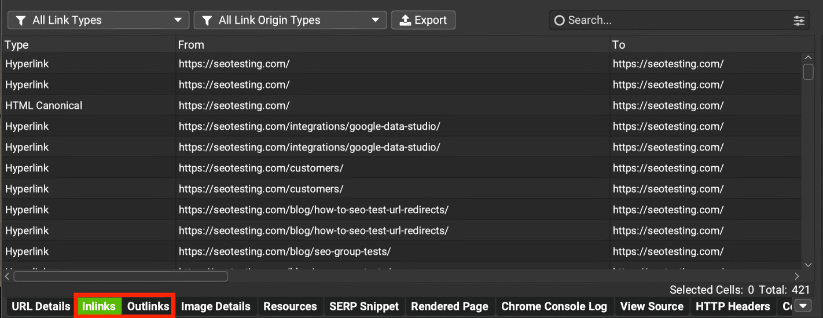
Links to Redirected Pages
Another issue you need to look out for is links on your website that are sent to pages that have been redirected. This is not necessarily an issue. However, too many links to redirected URLs can cause issues, primarily with the speed at which search engines can crawl and index content, as they must pass through many redirects to get to the correct URL.
Going back to all the instances of redirects on our Screaming Frog crawl:
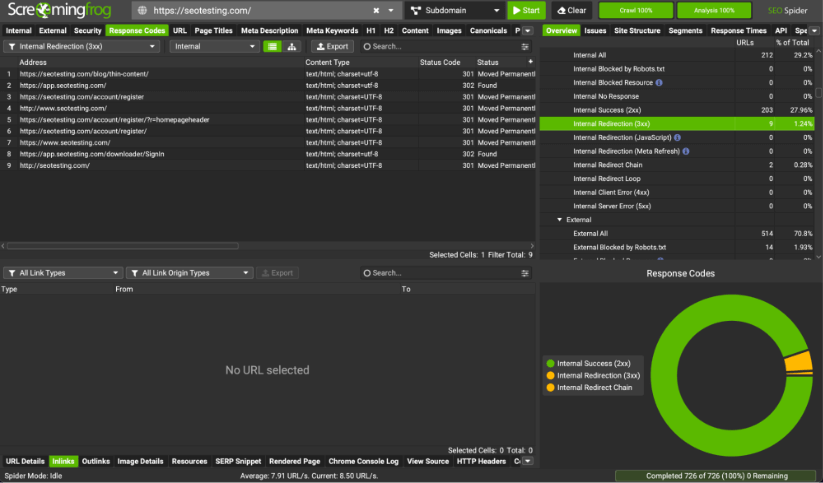
We can then click on each redirected link and find where this is located on our site using the inlinks and outlinks filter:
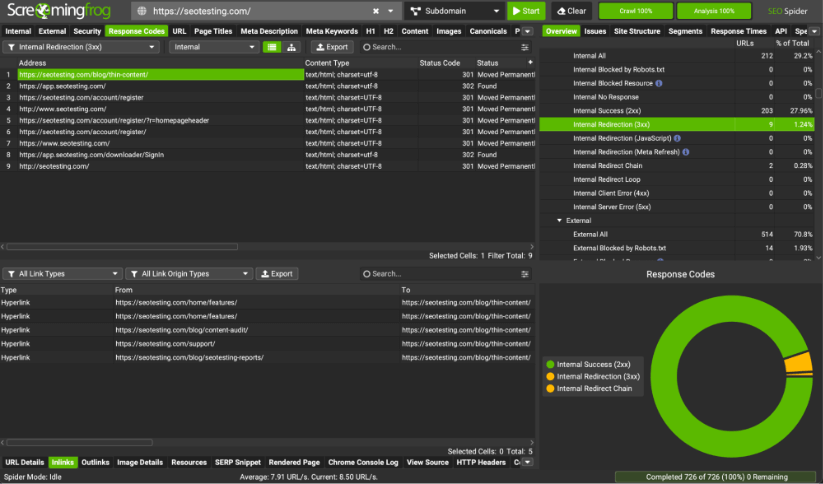
As we can see from the screenshot above, our redirected URL to our blog post on thin content has been linked to from:
- Our features page.
- Our content audit blog post.
- Our support page.
- Our blog post on the different SEOTesting reports.
We should go to these pages, remove the redirected link, and replace it with the correct link without the redirect.
Redirect Chains
The next step is to check your internal links for instances of redirected URLs, and especially redirect chains. Again, crawling tools like Screaming Frog make finding every example of redirects on your website easy.
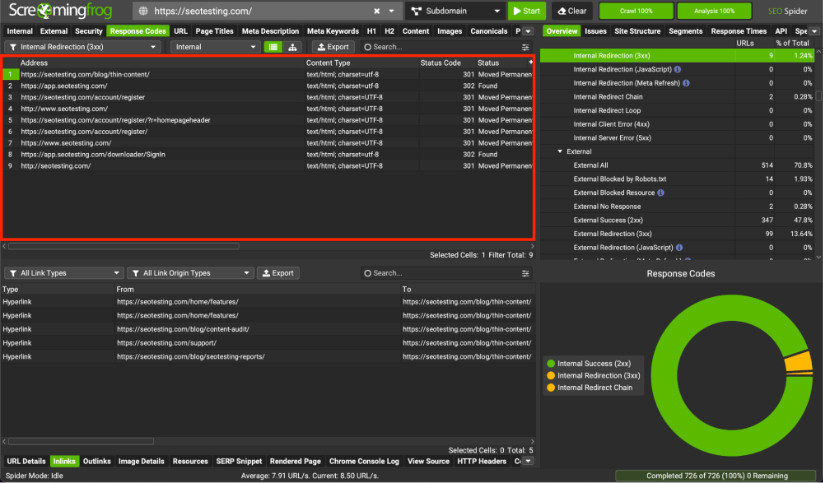
The above screenshot shows every instance of a redirected internal link on our website. Most of them are permanent redirects containing 301 response codes, but there are also temporary redirects demonstrated with a 302 response code.
Unfortunately (for this guide, anyway), our website does not contain redirect chains. However, we will still show you how to find redirect chains if you wish to look for them on your website.
Screaming Frog makes it very easy to find redirect chains. In the same section that we went into to find instances of broken links, you can also view cases of redirect chains and redirect loops, as shown in the screenshot below:
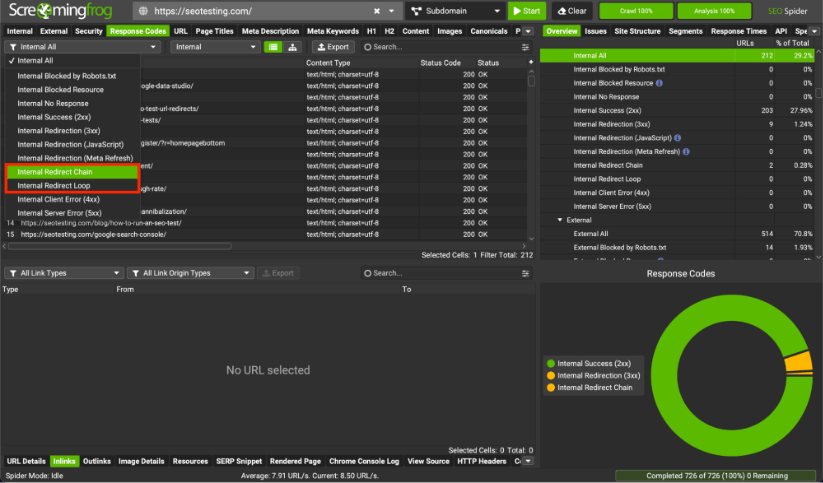
Assess Link Distribution
You can also use your site crawl to assess the distribution of internal links across your website. Generally, the more influential the page is to your business (and, therefore, your users), the more internal links it should have.
To show Google (and other search engines) that this page is essential, you must ensure that many internal links are pointing to it.
ScreamingFrog has a great feature that can help you do this relatively quickly. If you look at the main crawl result section of your SF crawl, you can use the horizontal scroll bar to head most of the way across. You will then be greeted with an ‘inlinks’ column for every single one of the pages crawled! Then, it’s simply a case of sorting by pages with the most internal links, as shown in this screenshot:
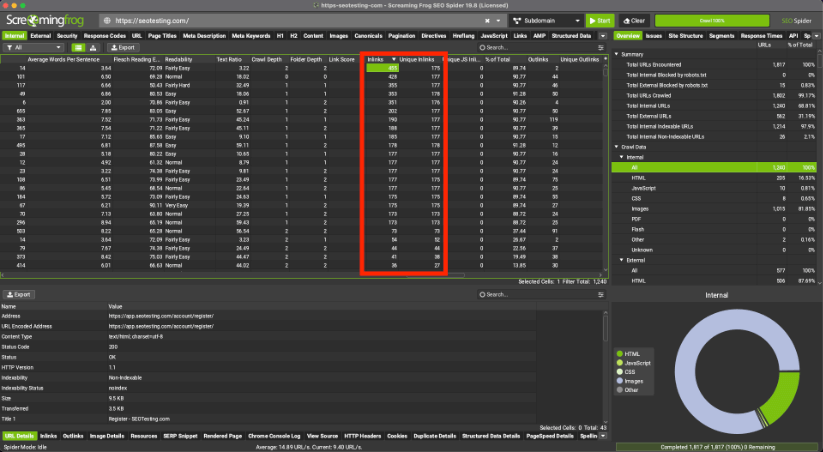
You’ll also note that there is an additional column showing the number of unique internal links each page has. This is great as it gives your data an extra granular layer to consider during your analysis.
Check for Orphan Pages
On the flip side of assessing link equity across your website, you must also identify orphan pages. An orphan page is any page on your site that cannot be accessed via any internal links, even if it is accessible via your website’s sitemap.
To find orphan pages on our website, we first need to set up our crawl configuration to only crawl our website’s sitemap. If we open up our crawl configuration on Screaming Frog, we can input the following settings:
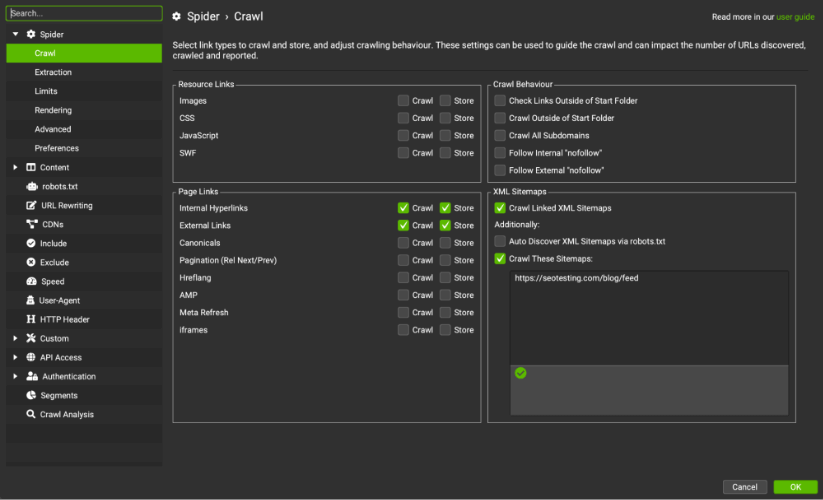
This will ensure that only our sitemap is crawled.
We can then run another crawl of the site:

From here, we can export the crawl to a Google Sheet, which will only show our orphan pages that Screaming Frog has found:
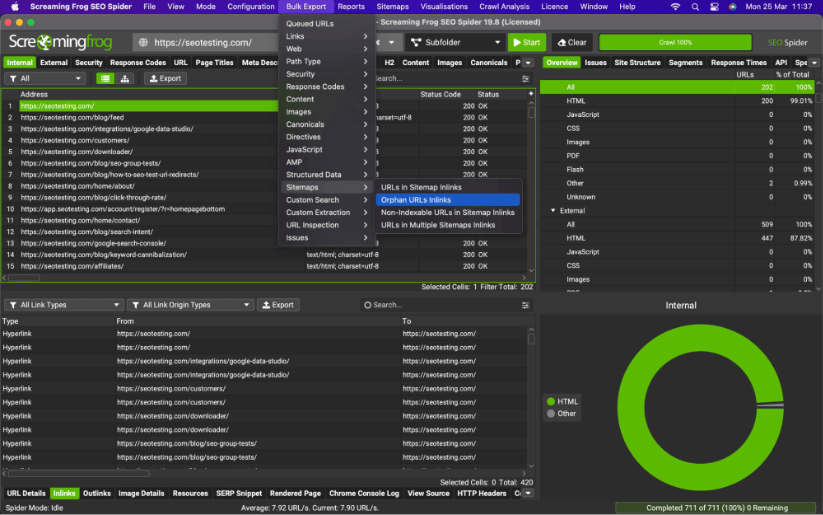
Optimize Anchor Text
We can also utilize our website crawl file to examine the anchor text of all our internal links. Again, this is a time-consuming process, but it is necessary, as anchor text helps search engines and, more importantly, users understand the link and why it is there. It’s one of the best ways to allow search engines to understand what these pages are about.
Your first step in doing this will be to take your website crawl, and find the page you are wishing to improve the internal link optimization of. For this example, we’ve chosen our Introduction to Google Search Console:
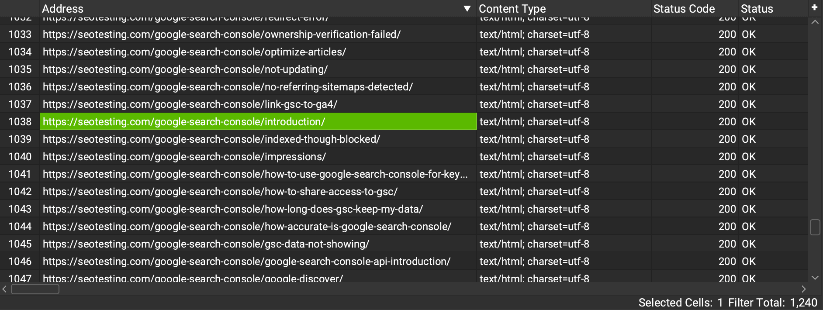
Next, head to the details panel at the bottom of your crawler, and select the ‘Inlinks’ button. This will show a list of all the internal links to this particular page. You will also notice that your crawl has extracted the anchor text for each of these internal links also.
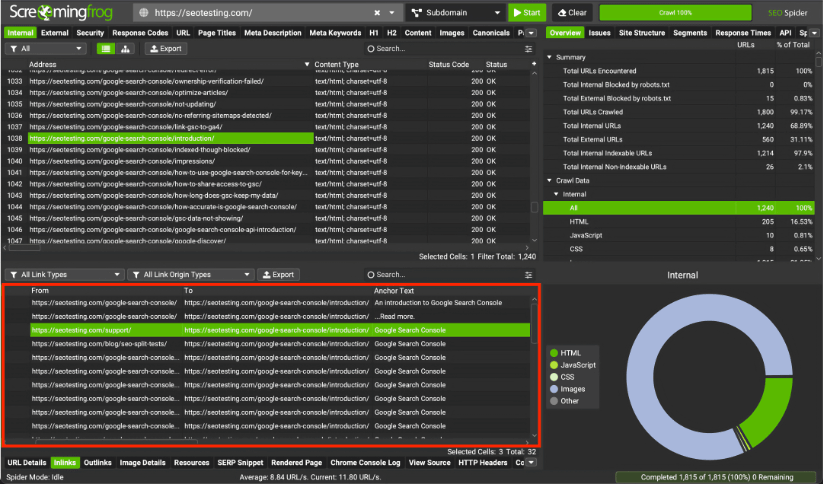
As you can see from the screenshot above, the vast majority of anchor text for these internal links is ‘Google Search Console’ and there is almost no variation. This is something we could look at in order to improve the page. Do we need to start variating the anchor text? Do we need to change some of this anchor text to something more natural? This is something we can now decide as a team, so we can make changes and test to see if our changes have a positive or negative impact!
When optimizing anchor text for internal links on websites, you need to tread a fine line between over and under-optimization. Both extremes can hinder your site’s performance in search engines. Luckily, a strategic and common-sense approach can strike a good balance.
In my opinion, the best practice for writing internal link anchors revolves around being thoughtful. More importantly, though, you need to remember that you’re writing these anchors for the people on your site, not the search engine bots.
Write for the people and the bots will soon follow.
Aim for relevance and clarity, using anchor text that describes the linked page’s content while naturally slipping a few relevant keywords in there. Let’s say, for example, that you’re linking to a page on your website about marketing plans, but the blog post is focused on how to write a marketing plan. Rather than simply writing “marketing plan” as the anchor text, just tell the user what it is. Instead, write “how to write a marketing plan.”
A Note on Click Depth
Analyzing the click depth of your most important pages is another step you can look at during your internal link audits.
Click depth refers to the number of clicks it takes to reach a particular page on your site from the homepage. Pages buried deeper within a website are seen less by users and search engine bots.
By ensuring that important pages on your site are easily accessible, I am talking about within a few clicks from the homepage, you can enhance their discoverability, which may lead to improved user engagement and better rankings for that page.
There are great ways to visualize this. ScreamingFrog allows you to see a crawl tree graph of your site, which you can use to see how deep pages are within your site architecture! Here’s an example of a crawl tree for SEOTesting’s site:

Prioritize Issues for Correction
We are nearly at the stage of completing our audit now, and one of the last steps you need to complete before you fix the issues you have found is to prioritize the order in which you will fix the problems.
Generally, you want to fix the more important issues first, as these will have the most significant impact. However, if some problems take minimal time, you should correct them first. The order in which you fix errors and issues following your internal link audit will depend on your available resources and time allocation.
A strategic approach to prioritizing these tasks might be to use the ICE framework, a method that is often used across different marketing tasks because it scores each individual job based on its impact, confidence, and ease.
First, you evaluate the potential impact of fixing each issue you have found. Ask questions like: How much could this improve my site’s usability? Next, assess your confidence that these fixes will give you the expected outcome. Do you have evidence or past tests to support this? And finally, estimate how easy it will be to implement each fix.
Then, once each task has a score associated with each section within the ICE framework, you can average it out and sort the tasks from highest to lowest importance.
If you are struggling, you can use Screaming Frog as a guide for which issues to sort as a matter of urgency, as they do provide this information:
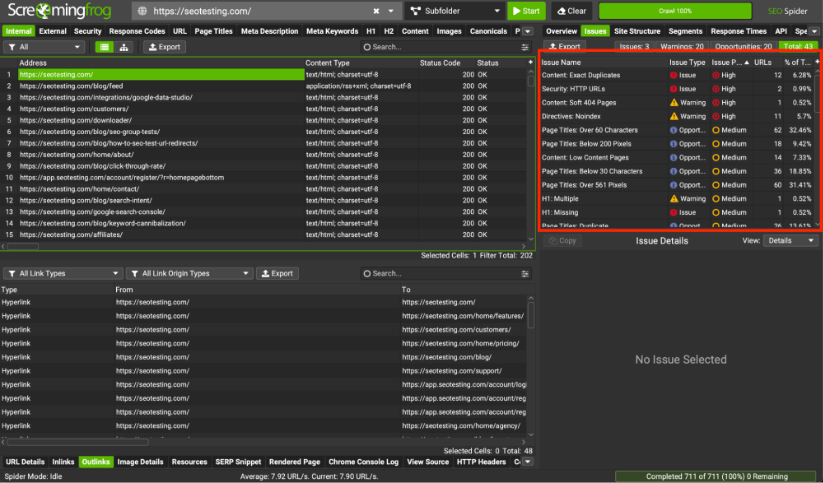
Remember that Screaming Frog will show you all the issues, warnings, and opportunities here. You must filter these yourself, as there is no way to filter for problems specific to your internal links automatically.
Fix Issues
Now, you need to start work on fixing the issues that you have come across. As you have gone through this audit, you will want to note all the problems you find so you can send these to your peers and stakeholders in the order of priority they need to be fixed. You can then move these and start to correct them.
If there are broken links, remove them or correct the URLs. If you have found redirect chains or loops, solve them.
Similarly, if you have found links to redirected pages, you may change these internal links to the redirected URLs. If you have discovered orphan pages, add a few internal links from relevant pages to these orphan pages so they can also be found on your site, not just via the sitemap.
Document Changes & Create SEO Tests
As a final but crucial step, you must document the changes you make to your site and test what changes you make following your internal link audit.
This is a great way to keep track of the changes you are making. It will also allow you to revert the changes if you see negative results, although this is rare as you will fix issues with your website’s internal linking structure and hierarchy.
You can do this in whatever way suits you best, whether through a spreadsheet in Microsoft Excel or Google Sheets. You can also do this with your internal site changelog, or if you have a subscription to SEOTesting, you will find that your site changelog is kept up-to-date for you as you create SEO tests.
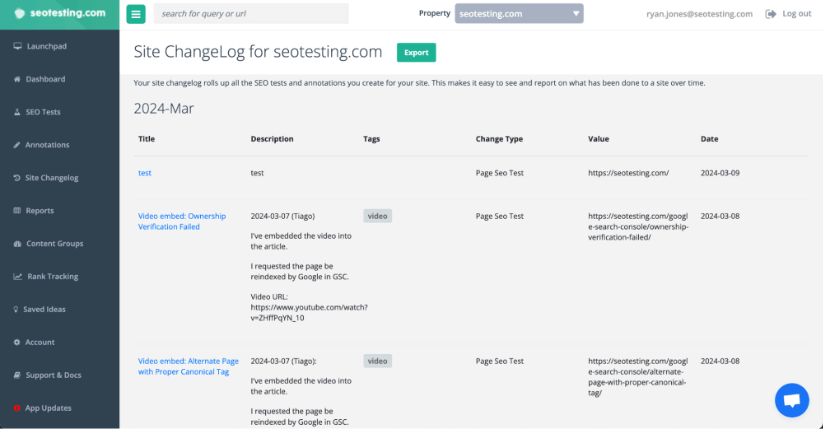
When you utilize SEO testing for each change you make following your internal link audit, these changes will automatically be added to your site changelog within SEOTesting, which will help you (and the rest of your team) keep track of what changes have been made to your site and what impact these changes have had.

You can also make use of the ‘Annotations’ feature within SEOTesting to make additional notes of what has been done on your website:
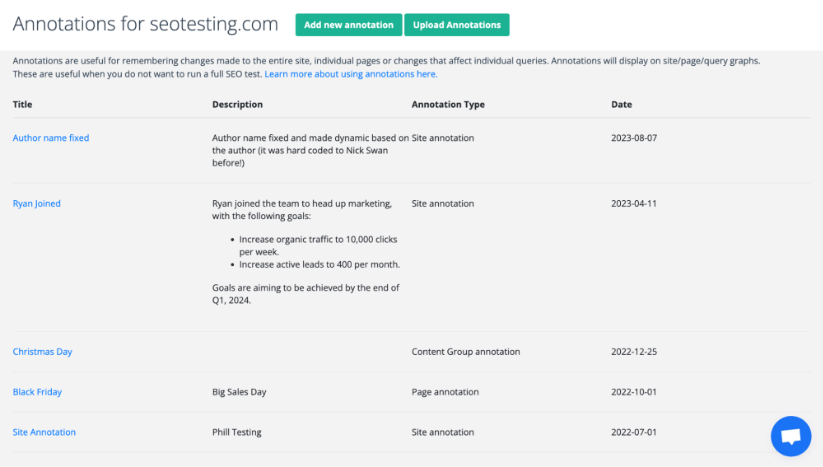
These annotations will then be kept, and you can see these as part of your site/page/query graphs:
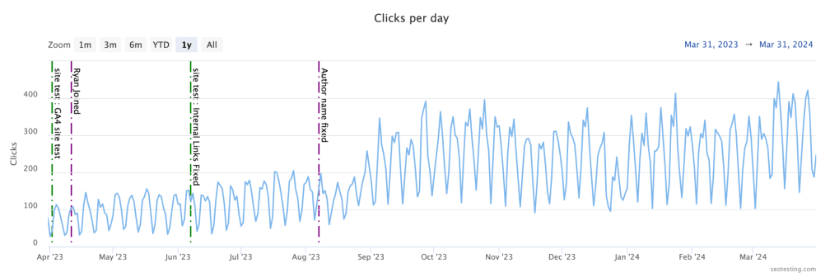
Here’s an example of an SEO test we completed after adding 21 internal links to this blog post on other website pages. As you can see, the results speak for themselves, significantly increasing the number of organic clicks to the article.

Wrapping Up
This comprehensive guide on internal link audits demonstrates that such audits are not just a minor aspect of SEO but a cornerstone of effective search engine optimization.
The strategic use of internal links plays a pivotal role in the success of any SEO campaign, from enhancing site navigation to boosting page authority and improving search engine rankings.
Tools like Screaming Frog and Sitebulb are invaluable in this process. They provide detailed insights enabling SEOs to optimize their sites’ internal linking structure.
An internal link audit is a critical step towards achieving your website’s full SEO potential, whether addressing orphan pages, redirect chains, or ensuring that your most important pages receive the visibility they deserve.
This guide has walked you through every process step, ensuring you have the knowledge and tools to make the most out of your internal links.
If you are looking for an SEO testing tool that will help you track the results of different changes to your website following internal link audits, then give SEOTesting a try. We run a 14-day free trial with no credit card required, so sign up today and start testing.


